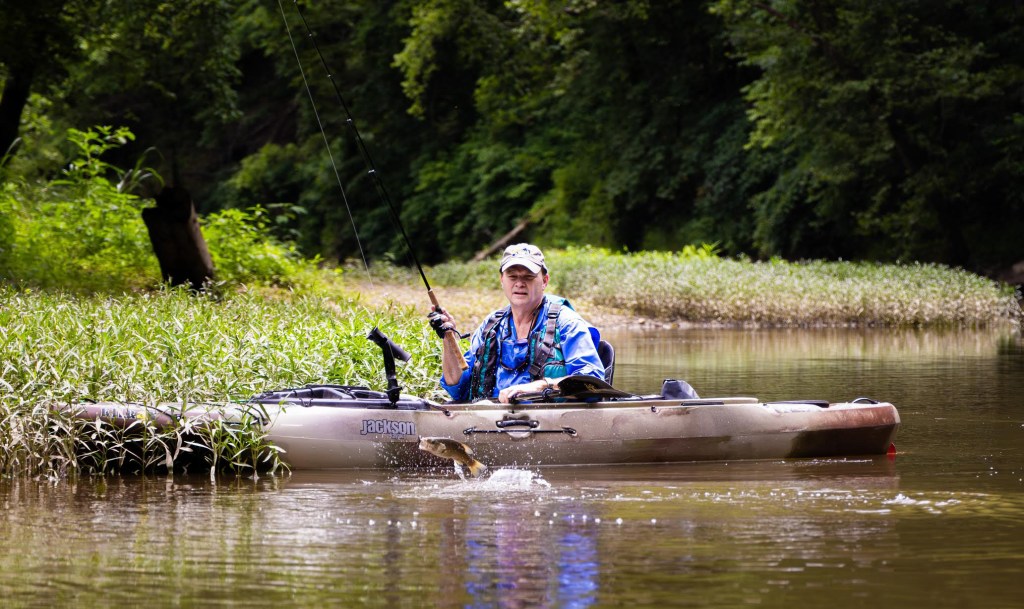Kayak fishing tips for summer success
Published 3:03 pm Thursday, June 29, 2023

- The author battles a smallmouth bass on Russell Creek in south-central Kentucky on a recent float trip for an upcoming segment of the Kentucky Afield television show. Use these five tips to improve your enjoyment and fishing success while paddling Kentucky streams this summer. Kentucky Afield photo
BY LEE MCCLELLAN
Kentucky Afield
The meat of the summer heat is here and will remain until late September. For many paddlers, the first days of summer mean the start of kayak fishing season and time to get their boats wet for the first time in months.
Trending
Stream smallmouth bass bite willingly during the hottest stretches of the year. Floating and wading a smallmouth stream is one of the best ways to escape the suffocating heat and humidity of a Kentucky summer.
However, if you’re a little rusty because you haven’t had your boat in the water since last summer, remember these five tips to improve the enjoyment of your summer float trips and put more fish in hand.
Do not bite off more than you can chew
This old saying has two meanings for a paddler: Do not attempt to paddle a stream with rapids greater than your skill level and avoid making the float too long if you want to fish.
Do your research before floating a new stream or section. Start by consulting the Kentucky Fish and Wildlife website at fw.ky.gov. Click the Canoeing and Kayaking page then surf the Blue Water Trails tab and the Stream Fisheries tab. It is a good idea to consult the Kentucky list for the American Whitewater webpage — americanwhitewater.org; it classifies the rapids on many streams in Kentucky.
If you are beginner or if you mainly paddle flatwater, such as a small state-owned lake, keep your choices to streams with rapids rated no higher than Class I. The higher the number, the more technical the rapid, with Class I being the easiest level. If you have little paddling experience, trying to negotiate rapids that are Class II or higher is dangerous folly. Learn to run the easier rapids before attempting hairier drops.
Trending
If you’re fishing, keep your floats under 8 miles. At longer distances, you must pick and choose only the best-looking fishing spots to make sure you make the take-out by dark. Avoid floating in the dark at all costs. Even the best flashlight cannot show the proper line to take in a rapid or accurately reveal the depth of the water when it’s dark. Walking a loaded kayak through a shallow swift rapid at 10 p.m. can lead to a painful slip and fall. Mother Nature does not make soft, spongy rocks.
Do not blow up the fishing hole
The two most productive areas for smallmouth bass in a stream are the areas above and below a stream drop. Once you hear the roar of a rapid, you need to plan how to fish it without spooking the fish.
It’s best to fish for stream smallmouth bass in a slow and stealthy fashion. Work your way toward the shallows in the flowing water above the drop (the “tailout”), and fish it slowly. If possible, walk your kayak through the rapid, then beach it and wade fish the deeper flowing water below the rapid. This is where the better smallmouth often hide.
Many anglers don’t want to get out of their boat to fish. They miss many smallmouth bass, often because their boat spooked the fish. A 16-inch smallmouth bass hiding behind a large rock in 5 feet of flowing water likely will not bite if you float right over the top of it, casting a huge shadow and making noise. They don’t get large by being stupid.
Walk the boat through the edge of the rapid (using a rope if necessary), then wade-fish the productive water below and above it. If you must make up some time, paddle through the deep, current-free stretches. You can burn this water without regret.
Keep down noise and pressure waves as you wade
Slow and deliberate wading of small sections of stream with the best habitat greatly increases the chances of catching a memorable smallmouth bass. Look for larger fish holding in an undercut bank, behind a current break or in the seam where faster water meets slower water. Fish in these places will be wary.
Make your approach stealthier by getting out of the water completely and walking along the bank. Approach the productive water from downstream.
Once you enter the water to wade, feel the bottom with each foot for a secure hold before committing your weight. This keeps slips to a minimum and dampens the noise from your feet contacting bottom. Keep your body sideways to the current as much as possible to avoid creating pressure waves that go out over the water you plan to fish. Pressure waves from your body’s movement through the water can spook smallmouth bass.
Fishing submerged woody cover can be tricky
Windstorms over the past several years knocked trees and branches into the streambeds of many of Kentucky’s best smallmouth bass streams. Woody cover, especially in areas of the stream with current and depth, provides excellent smallmouth bass habitat. It can be tricky to fish.
It’s best to float past the woody cover then fish your lure parallel to the cover from downstream. You can more easily move a large smallmouth bass away from the sunken tree from downstream as the current helps push the fish away from the wood. Do not make the mistake of fishing a sunken tree from a perpendicular position, or straight across from the cover. All the smallmouth bass must do is dive straight down into the tree. You will likely lose the fish and your lure in this scenario.
A topwater lure is a good choice for fishing around sunken trees from now through early October. From June onward, early in the morning and dusk make the best times to fish a floating-diving Rapala style minnow lure over the woody cover.
Use the lightest weight possible
Fishing shows on television typically have anglers using large, heavy lures to catch largemouth bass from weedbeds or shoreline cover. For stream smallmouth bass, you need to think in the opposite direction.
Use the lightest weight you can for fishing soft plastic lures with a weighted head or a jig. Observe baitfish or crayfish in a stream. They don’t go straight to the bottom like a rock. They glide gracefully through the water and move subtly. You want your lures to do the same. In the low and clear water conditions commonly found in summer, a 3- or 4-inch Senko-style soft plastic jerkbait rigged wacky style falls slowly and tantalizingly through the water column. These lures are usually packed with salt and possess enough heft to get down without any weight, other than the hook. Green pumpkin and black make good color choices.
A 4-inch, fluke-style soft plastic jerkbait rigged with just a 3/0 offset worm hook provides enough weight to get the lure down. Allow the rig to sink, slowly lift the rod tip and let the bait spiral back down. Wary smallmouth that won’t hit anything else often crush this presentation. Albino shad, electric shad and pearl make productive colors for this technique.
Summer is here. Kentucky is blessed with miles of floatable, productive smallmouth streams. Use these tips to improve your experience while beating the heat.






